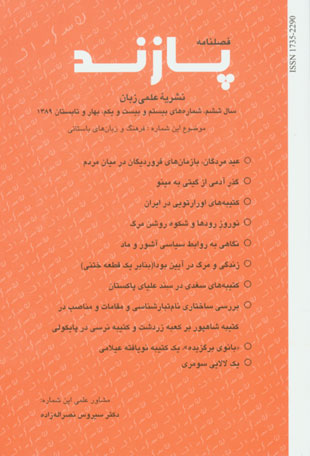فهرست مطالب

فصلنامه پازند
پیاپی 20-21 (بهار و تابستان 1389)
- 160 صفحه، بهای روی جلد: 16,000ريال
- تاریخ انتشار: 1389/10/25
- تعداد عناوین: 11
-
صفحه 5
-
صفحه 35
-
صفحه 73
-
صفحه 85
-
صفحه 103
-
صفحه 119
-
صفحه 139
-
صفحه 143
-
Page 7Despite the fact that socio-political events, impose changes on the dominant social systems and structures, however, the underlying social concepts and believes generally integrate with ideological and cultural structures and immerge in the newly built structures. That is why the concept of cultural continuum and intangible heritage came into existence. In such a frame of mind, the present paper deals with Iranians’ approach to death and the ancient belief in the returning of Fravhar.
-
Page 35Proceeding from Gētīg to Mēnōg, has set men to thinking. The current word to refer to this procedure is "death". Numerous words from the same root mar (= death) has been used in Avesta. But texts with religious content do not consider the corporeal death as an end to the life of man. As it is included in Avesta man is conceived of Five Forces, only two of which i.e. body and soul are eliminated by death. Two other forces, i.e. "rovān" and "daēnā" unify and compose the heavenly life of man.
-
Page 47The Urartian Empire rulled over the north west of Iran for two centuries. Numerous cuneiform inscriptions have remained from this era. The present paper introduces the Urartian Inscriptions in Iran, Which date back to the first millennium B.C.E.
-
Page 73The concept of Fravahar and the especial ceremonies of the dead, represents the Iranian ideology about death. Accordingly, Fravahar, as the heavenly self, is eternal, and continues to exist after death. Fravahar supports the survivors and is pleased by the happiness and content of the survivors. That is why Fravahar supports the pure, the true, water, the power to defend against war and generatively and reproduction. The performance of celebrations and benedictions gives power to Fravahar to flourish life. Like many other world cultures, in Iranian tradition, religious ceremonies are performed to honor Fravahar with the commencement of spring.
-
Page 85Political relations between Assyrian and Median Empires are investigated in this paper on the basis of Assyrian inscriptions, with a focus on official correspondences. These inscriptions were in exchange among the capital and the regional centers under the Assyrian dominance, and in which different political issues were reported to the king and his orders were issued. Therefore these inscriptions impartially narrate the details of the events.
-
Page 103The present text which is surveyed and translated from khotanese into Persian introduces a part of Buddha’s teachings. A garden is described in the text, in which Buddha took residence. It is spring time, and the beauty and pleasure of spring inspires the Shamans. Meanwhile Buddha commences his teachings by advising and informing them of the valueless world, and the cycle of life and death.
-
Page 119The present paper aims at introducing the Sogdian inscription.Sogdian is a middle eastern Iranian language, once spoken in Sogdiana. Among the middle Iranian languages, Sogdian is classified as belonging to the North-Eastern group. Numerous written sources have remained from Sogdian, which include both religious and non-religious sources. Inscriptions are among the non-religious written sources of this group. Sogdians inscriptions (rock) discovered in Upper Indus Valley, northern Pakistan are introduced in this paper.
-
Page 127The present paper compares two important Sasanid inscriptions: one is the three-lingual Shahpur inscription on Ka’be-ye Zardosht, and the other is the bilingual Narseh inscription in Paikuli located in Iraq. These two inscriptions are both significant for the way they narrate the political events of that era, and the references they make to kinship relations, internal structure of the government and official titles and dignitaries. This paper both surveys and makes a comparison between such references and narrations.
-
Page 139This paper introduces an Ilamite brick inscription, which is newly found in Izeh-Khuzistan. The inscription belongs to Šilhak- Inšušinak and it is about the goddess Upurkupak.

